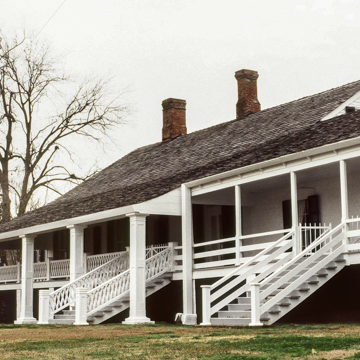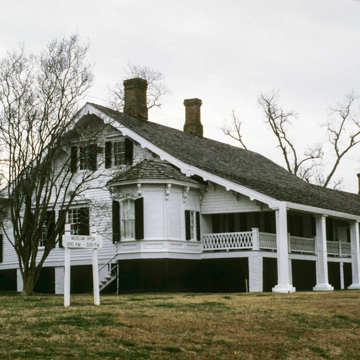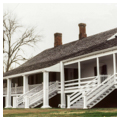You are here
Winter Quarters
This large, rambling house began as a raised three-room hunting lodge built by Job Routh in 1803 on his 800-acre Spanish land grant beside Lake St. Joseph, an oxbow of the Mississippi River. Routh apparently used the lodge only in winter, hence its name. De Bow's Review of 1853 identified Routh as the first permanent settler of Tensas Parish and the person who named the lake. Ann Ogden, Routh's daughter, was responsible for the second phase of construction in 1830, adding three rooms across the front of the dwelling along with front and side galleries. Around 1850, Dr. Haller Nutt purchased the house and added a large raised one-and-a-half-story wing to its east side. This consisted of a broad hall extending from the front to the rear of the house, four rooms, and front and rear galleries supported on piers reaching from ground level to the eaves of the double-pitched roof. Nutt installed a billiard room and two bedrooms in the half story above this new section. Shortly afterward, he attached a semi-octagonal bay to the northeast corner of the house. Inevitably, the building ended up with a complex floor plan, a broad, spreading outline, and miscellaneous architectural styles, although it is largely classical in inspiration.
Dr. Haller Nutt (1816–1864), a wealthy planter, scholar, and inventor, lived with his family at Winter Quarters for much of the 1850s and early 1860s. In 1860, construction began on his now-famous octagonal house, Longwood, in Natchez, Mississippi, approximately fifty miles south on the opposite bank of the Mississippi River. Nutt continued the experiments on cotton hybrids and seed breeding initiated by his father, Dr. Rush Nutt, and in 1841 produced a successful strain known as Egypto-Mexican cotton. He owned two cotton plantations in Tensas Parish: Winter Quarters and, adjacent to it, Evergreen, now demolished. Nutt prospered in the years immediately preceding the Civil War; in 1860, he owned 800 slaves and 42,947 acres on twenty-one plantations in Mississippi and Louisiana. At Winter Quarters, he possessed over 2,000 acres, more than 300 slaves, several cotton gins, a sawmill, and boat docks. During the Civil War, Nutt, who was said to be a Union sympathizer, vacated the area; he died in 1864. His wife, Julia, left in charge of Winter Quarters, met with General Ulysses S. Grant and offered to feed and quarter his troops in exchange for sparing her home. Later that year, however, Union stragglers burned the plantation’s other buildings and drove off the livestock. The war had a devastating effect on the family's holdings. Losses on the Louisiana plantations alone were estimated at over a million dollars, and the family was forced to sell Winter Quarters and Evergreen. Julia Nutt did finally receive some compensation for damage caused by both Union and Confederate troops. Winter Quarters now belongs to the Louisiana State Park system and is open to the public.
Writing Credits
If SAH Archipedia has been useful to you, please consider supporting it.
SAH Archipedia tells the story of the United States through its buildings, landscapes, and cities. This freely available resource empowers the public with authoritative knowledge that deepens their understanding and appreciation of the built environment. But the Society of Architectural Historians, which created SAH Archipedia with University of Virginia Press, needs your support to maintain the high-caliber research, writing, photography, cartography, editing, design, and programming that make SAH Archipedia a trusted online resource available to all who value the history of place, heritage tourism, and learning.








